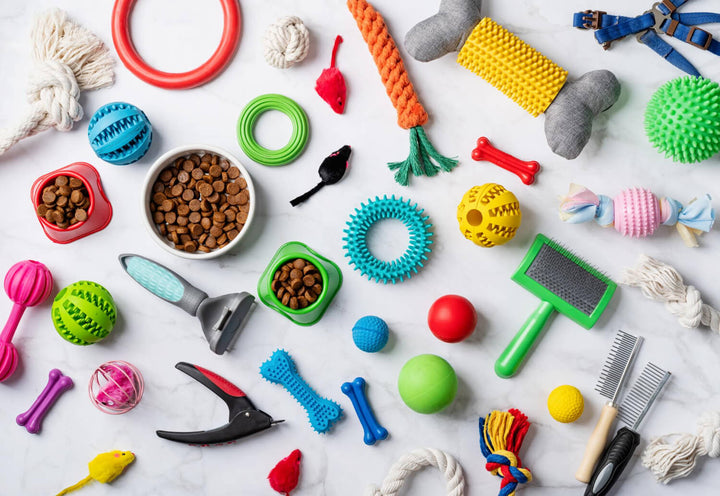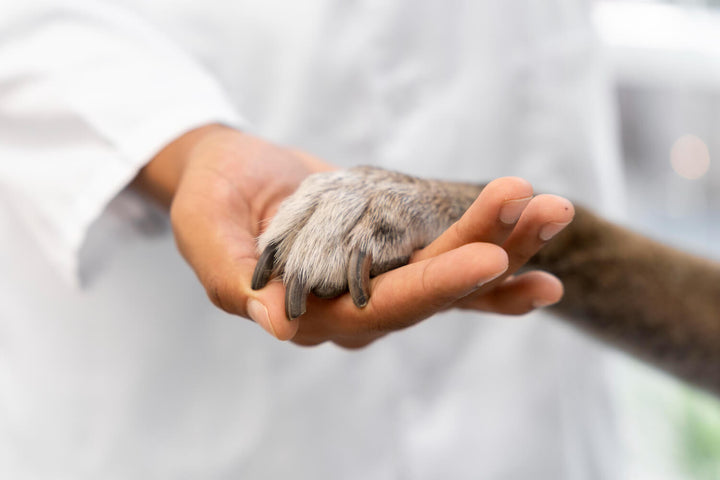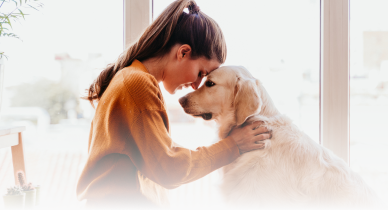The Maltese, with its long, flowing white coat and endearing personality, has captivated hearts for centuries. This elegant toy breed is not only a sight to behold but also a delightful companion. From their fascinating history to their charming traits, let's dive into the world of Maltese dogs.
Did You Know these Facts about the Maltese?
-
The Maltese breed has an ancient lineage, dating back over 2,000 years. They were cherished by royalty and nobility in civilizations including Rome and Greece.
-
Despite their small size, Maltese dogs have big personalities. They're known for their affectionate and lively nature.
-
Maltese dogs thrive on human companionship. They are known to be loyal and devoted to their families.
-
Maltese dogs have hair, not fur, which means they shed very little. This makes them a popular choice for people with allergies.
- Maltese dogs are excellent lap dogs. They love snuggling and being close to their owners.
The Maltese breed, with its charming demeanor and striking appearance, consistently ranks high in popularity lists; in fact in the AKC's popularity list, it reached number 38. Their timeless appeal and adaptability to various living situations contribute to their consistent demand.

Traits of the Maltese Breed
Personality. Maltese dogs are known for their gentle, affectionate, and lively personalities. They thrive on human interaction and are often described as "velcro dogs" because of their strong attachment to their owners. They are also intelligent and eager to please, which makes training a rewarding experience.
Family Life. Maltese dogs are excellent family pets, especially in households where they receive plenty of attention and affection. They get along well with children, although their small size means they may be better suited for families with older kids who can handle them gently.
Appearance. Maltese dogs are small and delicate, standing about 7 to 9 inches tall at the shoulder and weighing between 4 to 7 pounds. Their most distinctive feature is their long, silky white coat, which requires regular grooming to maintain its beauty.
They have expressive dark eyes, a black button nose, and ears that hang gracefully to the sides of their face.
While the breed standard calls for pure white coats, some Maltese may have light lemon or tan markings, but these are considered faults in the show ring.
Sociability. Maltese dogs are social butterflies. They thrive on interaction with their human family members and often enjoy the company of other dogs. Due to their small size, they may be more comfortable around similarly sized or gentle playmates.
Average Sizes & Life Expectancy
- Height: 7 to 9 inches tall (18 to 23 cm)
- Weight: 4 to 7 pounds (1.8 to 3.2 kg)
- Life Expectancy: Around 12 to 15 years
Detailed Description of the Maltese Breed
Appearance. The Maltese is a small toy breed that exudes elegance. They stand at about 7 to 9 inches (18 to 23 centimeters) at the shoulder and typically weigh between 4 to 7 pounds (1.8 to 3.2 kilograms).
One of their most striking features is their long, flowing, and silky white coat, which drapes gracefully over their slender frame.
Their eyes are round, dark, and expressive, often framed by dark halos that enhance their gentle gaze.
Another distinctive feature is their black button nose, which complements their dark eye rims.
Their ears, heavily feathered, hang close to their head. The tail is plume-like and carried over the back.
Temperament. Maltese dogs are renowned for their sweet and affectionate nature. They are devoted to their human companions and thrive on close bonds. They are often described as "velcro dogs" due to their tendency to stick close to their owners. Their loyalty knows no bounds, and they can be exceptionally protective of their family.
These little dogs are not just cute; they are also intelligent. They are quick learners and often excel in obedience training. Their intelligence makes them adaptable to various activities and environments.
Adaptability. Despite their small size, Maltese dogs are remarkably adaptable. They can thrive in apartments or houses with small yards, making them suitable for both urban and rural living. They are also adaptable when it comes to interacting with children, other dogs, and even cats, provided they are introduced gradually and properly socialized.
Care Guidelines. The Maltese's stunning coat requires diligent grooming to maintain its beauty. Daily brushing is essential to prevent matting and tangling, and regular baths help keep the coat pristine. Many Maltese owners opt for professional grooming to achieve the breed's characteristic long, showy coat.
While they are not high-energy dogs, Maltese dogs do enjoy a daily walk or playtime in a secure yard. Due to their size, they don't require extensive exercise, making them suitable for less active individuals or seniors.
Training Strategies. Early socialization and training are crucial for Maltese puppies. They respond well to positive reinforcement methods and thrive on praise and treats. Consistent, gentle training is key to raising a well-behaved Maltese.
Notable in History and Pop Culture. The Maltese breed has a rich history that spans over 2,000 years. They have been adored by royalty and nobility throughout various civilizations, including the Roman and Greek empires. The breed takes its name from the island of Malta, where they were highly favored and revered companions.
Maltese dogs have made appearances in various aspects of pop culture. They have been featured in paintings, literature, and even movies. One of the most notable appearances is in the film "The Silence of the Lambs," where a Maltese named Precious played a memorable role.
In conclusion, the Maltese breed is a true gem among dog breeds. Their elegant appearance, affectionate personality, and adaptability make them wonderful companions for a wide range of individuals and families. Whether as a faithful lapdog or a stylish show dog, the Maltese's charm and timeless allure continue to captivate hearts around the world.
What to expect when living with the Maltese Breed
Personality. Maltese dogs are renowned for their affectionate nature. They form strong bonds with their owners and thrive on human interaction. They are often described as "velcro dogs" because they love to be close to their family members. Expect your Maltese to follow you around the house, cuddle with you on the couch, and shower you with kisses.
Despite their small size, Maltese dogs have a playful and energetic side. They enjoy interactive playtime and toys that stimulate their minds. They'll happily engage in games of fetch or chase and are known for their agility.
Ideal Environment. Maltese dogs are adaptable and can thrive in various living environments. Whether you live in a bustling city apartment or a quiet suburban home, your Maltese will adjust well, as long as they receive the attention and love they crave.
Maintenance Level. Maltese dogs do not have high exercise requirements. A daily walk or some playtime in a secure area is usually sufficient to keep them happy and healthy. This makes them a great choice for individuals or families with a more relaxed lifestyle.
One aspect that potential Maltese owners should be aware of is the breed's grooming needs. Their long, silky coat requires daily brushing to prevent matting and tangling. Many Maltese owners opt for professional grooming to maintain the breed's elegant appearance. Regular baths and paw care are also essential to keep them looking their best.
Overall Health Expectations and Best Health Tests for the Maltese Breed
Health Considerations. Maltese dogs are generally healthy, but like all breeds, they can be prone to certain health issues. Being aware of these potential health concerns and conducting the right health tests can help ensure a long and happy life for your Maltese companion.
Maltese dogs can be susceptible to certain conditions, including dental issues, patellar luxation (knee joint problems), and heart problems. They may also be prone to eye conditions such as cataracts and progressive retinal atrophy (PRA).
Recommended Health Tests. To maintain your Maltese's health, it's essential to schedule regular veterinary check-ups. Your veterinarian may recommend specific tests based on your dog's age and health history. Common tests for Maltese dogs include dental examinations, knee evaluations, and eye exams to check for any signs of potential issues.
Dental care is particularly important for Maltese dogs because they are prone to dental problems. Regular teeth brushing, dental chews, and professional cleanings can help prevent dental issues.
As with many small breeds, monitoring your Maltese's heart health is crucial. Regular veterinary check-ups can include heart assessments, especially as your dog gets older.
Regular eye examinations can help detect and address any potential issues early. Keeping your Maltese's eyes clean and free from discharge can also contribute to their overall eye health.
Best Nutrition, Diet & Supplements for the Maltese Breed
Nutrition and Diet. Selecting high-quality dog food is the first step in ensuring your Maltese receives the best nutrition. Look for dog food brands that list a high-quality source of animal protein, such as chicken, turkey, or fish, as the first ingredient. Avoid foods that contain fillers like corn, wheat, and soy, as these can be hard for Maltese dogs to digest.
This breed thrives on a diet that provides around 18-25% protein content. Protein is crucial for muscle maintenance and overall energy levels. Ensure that the protein source is easily digestible, as Maltese dogs can have sensitive stomachs.
Healthy fats, such as those found in fish oil, are beneficial for Maltese dogs. Omega-3 fatty acids support skin and coat health and help reduce inflammation. Look for foods that contain these essential fats or consider adding a fish oil supplement to your Maltese's diet.
Maltese dogs do well with carbohydrates from sources like sweet potatoes, brown rice, and oats. These complex carbohydrates provide a steady source of energy and help maintain stable blood sugar levels.
Maltese dogs are prone to obesity, so it's crucial to practice portion control. Follow the feeding guidelines on the dog food packaging, and monitor your dog's weight regularly. Adjust portion sizes as needed to maintain a healthy weight.
Hydration is Key. Adequate hydration is essential for Maltese dogs. Encourage your dog to drink plenty of water.
Supplements. While Malteses can receive essential nutrients from a balanced diet, some supplements can support their overall health. Omega-3 fatty acids, such as fish oil, can help maintain healthy skin and coat. Probiotic supplements can help maintain a healthy digestive system, especially for Maltese dogs prone to tummy troubles.
Foods to Avoid. Some Maltese dogs may be sensitive or allergic to certain ingredients. Common allergens include beef, dairy, and grains like corn and wheat. If your Maltese displays signs of food allergies, such as itching, digestive upset, or ear infections, consider switching to a limited-ingredient or hypoallergenic diet.
Grooming Requirements for the Maltese Breed
Coat Maintenance and Shedding. The Maltese coat is long and prone to matting and tangling. Daily brushing is essential to prevent mats and keep the coat in good condition. Use a slicker brush or a pin brush to gently remove tangles and debris. Many Maltese owners opt for professional grooming every four to six weeks. Professional groomers can provide a breed-specific haircut and ensure your dog's coat is in top condition.
Paw Care and Hygiene. Trim your Maltese's nails regularly, usually every two to three weeks. Long nails can cause discomfort and affect their gait. Pay attention to the hair between the paw pads, as it can mat and collect debris.
Ear and Eye Care. Check your Maltese's ears weekly for dirt, wax buildup, or signs of infection. Gently clean the ears with a dog-specific ear cleaner and a cotton ball. Avoid inserting anything into the ear canal. Maltese dogs often have tear staining due to their shallow eye sockets and excessive tearing. Clean their eyes daily using a damp cloth to prevent staining. Consult your veterinarian if tear staining becomes severe.
Bathing Frequency. Maltese dogs benefit from regular baths to keep their coat clean and white. Use a high-quality dog shampoo and conditioner to maintain the coat's silkiness. Depending on your dog's activity level and environment, you may need to bathe them every two to four weeks.
Exercise Required for the Maltese Breed
Maltese dogs thrive on interactive play. Engage them in games of fetch, tug-of-war, or hide-and-seek. These activities not only provide physical exercise but also mental stimulation. Daily walks are beneficial for Maltese dogs. Aim for at least two 15-20 minute walks per day. They enjoy exploring their surroundings and meeting other dogs.
Maltese dogs are adaptable and can exercise indoors. Interactive toys, puzzle feeders, and indoor agility courses can keep them active and entertained, especially in inclement weather. Expose your Maltese to different people, pets, and environments from a young age. Socialization helps prevent behavioral issues and ensures they are comfortable in various situations.
Training Tips for the Maltese Breed
Maltese dogs are intelligent and highly trainable dogs. Effective training is crucial to channel their energy and ensure they are well-behaved companions.
Do…
- Use rewards including treats, praise, and toys to motivate and reward good behavior.
- Keep training sessions short and engaging to prevent boredom and maintain their interest.
- Expose your Maltese to various people, pets, and environments from an early age to ensure they become well-adjusted and confident adults.
-
Be consistent with your commands and expectations. Use the same cues for specific behaviors.
Don't…
- Use harsh training methods or punishment, as it can lead to fear and anxiety in your Maltese.
- Skip socialization. Neglecting socialization can result in shyness or fearfulness.
- Overfeed treats. While treats are useful for training, be mindful of overfeeding, as Maltese dogs can gain weight quickly.
The Maltese Breed is Suitable For
Maltese dogs are well-suited for apartment living due to their small size. They don't require a large yard, making them ideal for urban dwellers. They can thrive in family homes. They are generally good with children, but early socialization is essential to ensure they are comfortable around kids. Supervision is necessary when young children interact with any dog to prevent accidental rough handling.
Maltese dogs make excellent companions for seniors. Their small size means they are easy to manage, and their affectionate nature provides companionship and emotional support. Whether you're single or part of a couple, a Maltese can be a loving addition to your life. They form strong bonds with their owners and provide companionship.
Maltese dogs can coexist with other pets, including cats and other dogs, especially if introduced to them at a young age. Supervision and proper introductions are essential to ensure everyone gets along. These dogs are adaptable when it comes to activity levels. They enjoy playtime and short walks but are also content to relax indoors. This makes them suitable for both active and less active owners.
The Maltese Breed is Not Suitable For
Maltese dogs are not suited for outdoor living. They thrive on human companionship and should be kept indoors with their families. Extreme weather conditions can be detrimental to their health. While Maltese dogs are generally good with children, they are small and delicate. Rough handling or unsupervised interactions with young children can lead to injuries. Always supervise interactions to ensure safety.
Maltese dogs require regular grooming, socialization, and attention. They are not suitable for homes where they may be left alone for long periods without proper care and companionship.
Famous Maltese Owners
-
Marilyn Monroe - The iconic Hollywood actress Marilyn Monroe was a famous Maltese owner. Her Maltese dog, named Maf Honey, was known for its glamorous lifestyle, accompanying her to movie sets and premieres.
-
Halle Berry - Academy Award-winning actress Halle Berry is another celebrity who adores Maltese dogs. She has been spotted with her Maltese companion, named Whiz.
- Elizabeth Taylor - Legendary actress Elizabeth Taylor owned a Maltese dog named Sugar. Taylor's love for her furry companion was well-documented, and Sugar even appeared in some of her films.
Accomplishments of the Maltese Breed
Maltese dogs are not typically known for breaking world records, but they have a long history of being cherished companions. They are often depicted in various forms of pop culture, including movies, books, and television series.
For example, Maltese dogs have appeared in films like "Legally Blonde" and "The Parent Trap," further cementing their status as beloved pets. Additionally, their elegant appearance and friendly demeanor have made them popular subjects in art and literature throughout history. While they may not hold world records, Maltese dogs hold a special place in the hearts of many as loyal and charming companions.

The History of the Maltese Breed
Creation and Purpose. The Maltese breed is one of the oldest toy breeds with a history dating back over two millennia. Its origins are shrouded in the mists of time, but it is believed to have originated on the island of Malta in the Mediterranean, as its name suggests.
Ancient Origins. Maltese dogs are descendants of ancient toy-sized dogs, which were popular among the nobility and aristocracy of ancient civilizations, including the Egyptians, Greeks, and Romans. These tiny dogs were cherished for their small size and gentle disposition.
The Maltese found favor with the European nobility during the Renaissance period. They were a favorite among queens and princesses, most notably Mary Queen of Scots and Queen Elizabeth I. It was during this era that they received their name “Maltese.” These dogs were not only cherished as companions but also as entertainers in European courts. They were often trained to perform tricks and entertain royalty with their playful antics.
Their small size, elegant appearance, and gentle temperament made them ideal lap dogs and loyal companions to the nobility.
Early Roles and Evolution. The breed has maintained its distinctive appearance over the centuries. Maltese dogs are known for their long, flowing, white coat, dark, expressive eyes, and black button noses. Their silky, white coat requires meticulous grooming to keep them in prime condition.
Changes and Modern Impact. Today, Maltese dogs continue to be cherished as beloved family pets. Their role has evolved from entertainers and court companions to that of affectionate household companions. They are renowned for their affectionate nature and sociable personality.
While the essential characteristics of the Maltese breed remain unchanged, efforts have been made to preserve their health and vitality. Responsible breeding practices focus on maintaining the breed's distinctive traits while minimizing health issues.
The Maltese remains a popular breed worldwide, known for its charming personality and glamorous appearance. They are often seen participating in dog shows and events, showcasing their beauty and agility.
The Maltese Breed Standard
The Maltese belongs to the Toy Group according to the American Kennel Club (AKC). Toy dogs are known for their small size and charming personalities, making them perfect companions for families and individuals alike.
The AKC's formal Breed Standard for the Maltese describes the ideal representation of this breed. According to the standard, Maltese dogs should have a compact, fine-boned body covered with a long, silky, pure-white coat that drapes down to the ground. Their heads should have a slightly rounded skull with a well-defined stop. The eyes are dark, round, and expressive, while the nose and lips should be black.
Maltese have a lively, alert, and friendly expression. Their ears are V-shaped, well-feathered, and carried gracefully. They have a level topline and a well-carried tail that is plumed and arched over their backs. The breed standard also emphasizes the importance of a well-balanced gait, which should be effortless and flowing.
The American Maltese Association is the national breed club for Maltese dogs in the United States. They are dedicated to preserving and promoting the well-being of the breed. For more information, you can visit their official website at American Maltese Association.
General Appearance
Head, Muzzle, Nose. The Maltese dog is known for its striking head, which features a slightly rounded skull and a well-defined stop. The head is proportionate to the body and adorned with expressive, dark, round eyes that exude alertness and intelligence. This breed's eyes are set well apart, giving them a charming and lively expression. The Maltese has a fine, tapered muzzle that complements its elegant appearance. The nose is jet black, accentuating the dog's small, refined face. This breed should never exhibit a snub or short nose, adhering to the breed standard's specifications.
Teeth. Maltese dogs have a scissor bite, meaning their upper teeth neatly overlap their lower teeth. Proper dental care is crucial to maintain these small but strong teeth throughout their lives.
Neck. The neck of a Maltese is moderately long and gracefully arched, giving them a regal posture. The neck blends smoothly into the shoulders, contributing to their overall balanced appearance.
Body. Maltese dogs have compact bodies with a level topline. Their chests are moderately deep, and the ribs are well-sprung. The body should convey a sense of sturdiness beneath their luxurious coat.
Tail. The Maltese's tail is another notable feature. It is plumed and carried gracefully over the back, adding to their elegance. The tail should never be docked and should reach down to the hock joint.
Coat. The most striking aspect of a Maltese's appearance is its long, silky, and pure-white coat. This fine-textured, single-layered coat drapes down to the ground, creating a captivating and regal effect. Regular grooming is essential to maintain the beauty and health of their coat.
Size. Maltese dogs are a small breed. They typically weigh between 4 to 7 pounds (1.8 to 3.2 kilograms) and stand about 7 to 12 inches (18 to 30 centimeters) tall at the shoulder. Their small size adds to their charm and makes them perfect companions for various living situations.
Gait. Maltese dogs have an elegant and effortless gait. When they move, they should exhibit a smooth, flowing, and balanced stride. Their gait is indicative of their overall health and vitality, showcasing their sound structure.
Reputable Breeders
For those seeking a well-bred Maltese, there are reputable breeders who prioritize health, temperament, and the breed's standard. Here are a few notable breeders:
Top Shelters for Adoption
Adopting a dog can be a rewarding experience. Here are a few shelters where you might find a Maltese in need of a loving home:
Top 5 Frequently Asked Questions & Answers about the Maltese Breed
How big do Maltese dogs get?
Maltese are a small toy breed, typically weighing between 4 to 7 pounds and standing about 7 to 12 inches tall at the shoulder.
Are Maltese hypoallergenic?
Yes, Maltese are considered a hypoallergenic breed because they have hair instead of fur. This means they are less likely to trigger allergies in people.
Do Maltese dogs shed?
Maltese dogs do not shed much, if at all. However, their long coats require regular grooming to prevent matting.
Are Maltese good with children and other pets?
Maltese are known for their friendly and affectionate nature, making them good companions for families with children. They can also get along well with other pets, especially if socialized from a young age.
How much exercise do Maltese dogs need?
Maltese dogs are energetic but don't require excessive exercise. Daily walks and playtime are usually sufficient to keep them happy and healthy.
A Final Tip for Bringing a Maltese into Your Life
Bringing a Maltese into your life is like inviting endless joy, affection, and companionship. These charming little dogs are not just pets; they become cherished members of your family. With their loving nature, adaptability, and hypoallergenic coat, Maltese make wonderful additions to various households. Whether you're seeking a playful partner, a loyal friend, or a delightful lap dog, the Maltese breed offers it all. So, get ready to embrace a life filled with tail wags, snuggles, and unforgettable moments with your Maltese companion.
Valuable Resources for Your Journey to Parenting a Maltese
At Felicitails you will find many wonderful services, supplies and guides for your life ahead with a loving pup at your side.

Hope You Enjoyed The Read!
Tag Cloud

A warm welcome from Lindsay & Huck (my English Pointer). Hope you enjoy the read and find just what you are looking for when it comes to living your best life with your loved pets.

-
Dog Breeds
(42)
-
Emotional Support Animals
(10)
-
Dog Grooming
(6)
-
Dog Health
(18)
-
Life with a Dog
(18)
-
Dog Nutrition
(11)
-
Service Animals
(11)
-
Dog Training
(5)






